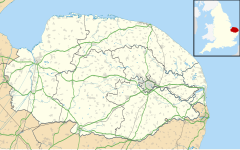world.wikisort.org - United_Kingdom
Burgh Castle is a village and civil parish in the English county of Norfolk. It is situated on the east bank of the River Waveney, some 3.7 miles (6.0 km) west of Great Yarmouth and within the Norfolk Broads National Park.[2] The parish was part of Suffolk until 1974.[3]
This article needs additional citations for verification. (December 2017) |
| Burgh Castle | |
|---|---|
 Church of St Peter and St Paul | |
 Burgh Castle Location within Norfolk | |
| Area | 6.76 km2 (2.61 sq mi) |
| Population | 1,150 (2011)[1] |
| • Density | 170/km2 (440/sq mi) |
| OS grid reference | TG476049 |
| Civil parish |
|
| District |
|
| Shire county |
|
| Region | |
| Country | England |
| Sovereign state | United Kingdom |
| Post town | GREAT YARMOUTH |
| Postcode district | NR31 |
| Police | Norfolk |
| Fire | Norfolk |
| Ambulance | East of England |


Roman Fort
Burgh Castle is the site of one of several Roman forts constructed to hold troops as a defence against Saxon raids up the rivers of the east and south coasts of southern Britain (the Saxon Shore). Possibly the fort was called Gariannonum, a name that appears in one original source;[4][5] the identification was once thought secure, but is now thought debatable by some specialists. The fort is roughly rectangular, approximately 205 m (673 ft) by 100 m (330 ft), with three of the tall massively built walls still extant; the fourth has fallen into what was once an estuary but is now a marsh, Breydon Water.
The site is owned by the Norfolk Archaeological Trust, with the walls in the care of English Heritage. The site is freely open to the public.[6][7]
Other history
Since William Camden, Burgh Castle has been suggested as the site of Cnobheresburg, the unknown place (a castrum or fort) in East Anglia, where in about 630 the first Irish monastery in southern England was founded by Saint Fursey as part of the Hiberno-Scottish mission described by Bede. Historians find many arguments against this location, but are unable to agree on a better one. The Roman fort at Burgh Castle was excavated by Charles Green during 1958–61. A detailed report by Norfolk Museums Service in 1983 (East Anglian Archaeology 20) found no evidence of any monastic settlement in Burgh Castle itself.
The church of Burgh Castle, St Peter and St Paul, one of 124 existing round-tower churches in Norfolk, has been a Grade II* listed building since November 1954.[8][9]
The civil parish of Burgh Castle has an area of 1,670 acres (680 ha) and in the 2001 census had a population of 955 in 376 households. For the purposes of local government, the parish today falls within the district of Great Yarmouth. However prior to the Local Government Act 1972, the parish was within Lothingland Rural District in Suffolk.[10][11]
The House of Burke take the original form of their surname de Burgh, from the area.[citation needed]
References
- "Parish population 2011". Retrieved 24 August 2015.
- Ordnance Survey (2005). OS Explorer Map OL40 - The Broads. ISBN 0-319-23769-9.
- "Parish Summary: Burgh Castle". norfolk.gov.uk. Retrieved 1 March 2017.
- "The Roman Map of Britain". romanmap.com. 5 January 2007. Archived from the original on 5 January 2007. Retrieved 27 April 2021.
- Crisp, F.R.J. (1825). The Mirror of Literature, Amusement, and Instruction. 143, The Strand, London: J. Limbird. pp. 257–158.
{{cite book}}: CS1 maint: location (link) - "English Heritage website: Burgh Castle". Retrieved 1 March 2017.
- "Burgh Castle - Norfolk Archaeological Trust". www.norfarchtrust.org.uk. Archived from the original on 26 October 2012. Retrieved 1 March 2018.
- Service, Norfolk Historic Environment. "Norfolk Heritage Explorer". www.heritage.norfolk.gov.uk. Retrieved 1 March 2018.
- Stuff, Good. "Church of St Peter and St Paul, Burgh Castle, Norfolk". www.britishlistedbuildings.co.uk. Retrieved 1 March 2018.
- Office for National Statistics & Norfolk County Council (2001). Census population and household counts for unparished urban areas and all parishes. Retrieved 2 December 2005.
- Local Government Act 1972, Schedule 1 Part II Non-metropolitan counties.
External links
- Map sources for Burgh Castle
- Gariannum Roman Fort, Roman-Britain.co.uk
- Burgh Castle fort at Norfolk Archaeological Trust
- Burgh Castle at genuki.org.uk
- Burgh Castle at English Heritage
- St Peter's and St Paul's on the European Round Tower Churches Website
- Photographs of the church and fort at flickr.com
- Hursey Pilgrims - Christian pilgrimage to Burgh Castle
Другой контент может иметь иную лицензию. Перед использованием материалов сайта WikiSort.org внимательно изучите правила лицензирования конкретных элементов наполнения сайта.
WikiSort.org - проект по пересортировке и дополнению контента Википедии